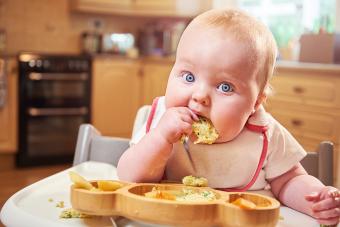
A baby's four-month mark is an exciting time! This is the average age when babies first get to try solid foods. While the age-old tradition is to spoon feed your infant an array of purees, there's a new approach that parents can try that may help diminish the instance of picky eaters and promote independence at the same time. This concept is called baby-led weaning. For parents curious about this technique, we've broken down the basics, pros, and cons of this self-feeding method for babies.
What Is Baby-Led Weaning?
Baby-led weaning (BLW) is a present-day approach to introducing solid foods. Pioneered by Tracey Burkett and Gill Rapley in 2008, this technique puts your baby in the driver's seat and has gained popularity since its inception. The concept is simple - instead of heading over to the baby aisle and grabbing a bunch of purees, parents can serve their infants the same foods that they are eating themselves! Not only does this introduce various textures and unique flavors sooner, but it may promote a healthier diet.
When to Start Baby-Led Weaning
Unlike traditional methods, baby-led weaning is a process that starts around the six-month mark. Your baby must possess a few key skills in order to begin their solid food journey:
- First, they must be able to sit up with little to no support. This means that they have full control of their neck and head movements and good trunk control.
- Second, their tongue-thrust reflex must be gone. This is the involuntary movement that a baby's tongue makes when a solid object enters their mouth. When present, your baby's tongue will push the item, in this case food, out of their mouth. This is a natural defense against choking. Unfortunately, it can make solid food feeding difficult.
- Last, your little one needs to be grasping items and bringing them to their mouth. Remember that every baby is different, so some will be ready sooner and others may need to wait a little longer than their half birthday to begin. Your baby's readiness is key to being successful in this venture, so don't rush into it.
Benefits of Baby-Led Weaning
Introducing solid foods from the start can seem like a scary concept, but many parents feel the benefits outweigh the drawbacks. Here are some of the key reasons parents try baby-led weaning - and a few things to consider in making the decision.
Improves Dexterity
Throughout your baby's first year of life, it is important for parents to help their child build a strong foundation for their future. BLW can create a bit of a mess, but it also gives your child regular opportunities to improve their fine motor skills and their hand eye coordination. This hones their ability to grasp smaller objects and effectively transfer them to their mouths. It will also sharpen their oral motor skills, the ability to chew and swallow, earlier than spoon-fed babies.
Promotes Healthy Eating Habits
Research on picky eating has shown that sensitivities to textures, flavors, and colors arise due to "early feeding difficulties, late introduction of lumpy foods at weaning, pressure to eat, and early choosiness." It also notes that the best way to prevent these issues is the offer fresh food options and to eat the same foods as your baby. Baby-led weaning promotes both of these concepts, lessening the risk that your child may turn into a picky eater.
This technique also teaches self-regulation. Your baby decides when they want more and when they are full. This reduces the instance of spit-ups due to overfeeding and it promotes healthier eating habits for your child's future.
Saves Parents Time and Money
Store-bought baby food is expensive - and making your own can be time consuming. Baby-led weaning allows parents to serve their little ones the same foods that they are eating each day. This makes it an affordable option, and it can be more practical for busy parents who have to juggle work or multiple kids' schedules.
Hones Social Skills
BLW encourages family mealtimes. This is a fantastic social interaction that is enhanced by the sensory act of eating. By engaging your child's sense of touch, taste, and smell, you are actually facilitating cognitive and language development. Parents can take this as an opportunity to introduce new words to their baby and it can serve as a great bonding experience.
Allows for Early Independence
As exciting as it is to watch your baby try new foods, spoon-feeding is a tedious process. By the time your baby finishes eating, your food is likely cold. In comparison, if your baby is feeding themselves, you can both enjoy the meal at the same time! This also builds their confidence, which can have a snowball effect on other activities.
Drawbacks to Baby-Led Weaning
While BLW is very popular among parents, there are a few disadvantages to the method. The good news is that we have tips on how to lessen the negative aspects of this method.
BLW is Messy
Bibs are no match for baby-led weaning. Giving your baby full control of their meal means that they also dictate where it lands; sadly, it's not always in their mouth. Mealtimes can become quite messy during BLW. Thankfully, there are products and parent hacks that can help to diminish this issue. These include using coverall-style bibs, placing butcher paper or a shower curtain liner on the floor to catch big messes, and covering your baby's eating surface with Glad Cling'n Seal for a simple cleanup.
Allergies Can Be Harder to Identify
One of the biggest upsides to purees is that you can easily identify if your child has an allergy or sensitivity to certain food types. Combination foods don't give you that option. If you are concerned about a potential reaction, consider putting certain ingredients aside as you are prepping your meal. For instance, if you are making Chicken Alfredo, leave some of your shredded chicken on the side before mixing in the milk-based sauce. Let them try the chicken or the noodles, but save trying milk for a separate occasion. Parents can slowly add in foods to their baby's meals to ensure that allergies are not a risk.
Safety Concerns Can Arise When Parents Don't Follow Guidelines
As with any eating experience, when parents don't follow certain guidelines, there can be a concern surrounding safety. Trying new foods is an exciting milestone for both baby and parents, but it's important that you wait until your baby is developmentally ready to start this activity. Every child will walk and talk at a different age. The readiness for starting solid foods is no different.
Once your baby is ready to take the wheel, it is imperative that parents monitor their child throughout the meal and follow the recommended food preparation guidelines. This can greatly diminish the instance of choking. For the parents who are still skeptical about taking this leap to solids straight from the bottle, rest-assured that researchers have found that the instance of choking is no greater than if you were to take a more traditional route. Therefore, by choosing baby-led weaning, you are simply teaching your child the importance of portion control sooner rather than later.
Decide if Baby-Led Weaning Is Right for You
If you are still weighing the baby-led weaning pros and cons, consider starting with a hybrid feeding method. Try out purees prior to six months and then switch over BLW after your little one meets the required milestones for solids.
BLW is not for everyone, but for the parents who want to try their hand at this feeding method, we have the recipe for success! Our baby-led weaning guide details everything that you will need to know about this exciting process, along with tips and tricks to make this culinary adventure a stress-free experience.







